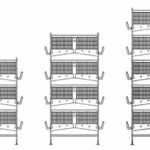Recap: Livestock WhatsApp Afrimash Feed Formulation 2.0 Free Training on the Livestock SMART Community on 31st May 2023
On 31st May 2023, the Livestock WhatsApp Afrimash Feed Formulation 2.0 Free Training took place on the Livestock SMART Community. The training aimed to provide participants with knowledge and skills related to feed formulation for livestock, specifically focusing on poultry. Here is a recap of the key points discussed during the training:
Introduction
In the world of poultry farming, formulating nutritious and balanced feed is crucial for the health, growth, and productivity of birds. To achieve this, it is essential to understand the role and purpose of each feed ingredient in the formulation process. In this article, we will explore the classification of poultry feed ingredients, their sources, and their significance in meeting the nutritional requirements of birds. Additionally, we will discuss various methods of feed formulation. So, let’s dive in and explore the fascinating world of feed ingredients!
Classification of Poultry Feed Ingredients
Classification of poultry feed ingredients is a vital aspect of feed formulation, as it enables us to create balanced diets for various bird species. By categorizing ingredients based on their source, we can better understand their nutritional contributions. Poultry feed ingredients can be broadly classified into five categories:
- Energy sources
- Fats sources
- Protein sources
- Vitamins sources
- Mineral sources
Now, let’s delve deeper into each category.
Energy Sources Ingredients
- Cereal grains
Cereal grains serve as essential energy sources in poultry feed formulation. They consist of the edible components of the grain, including the endosperm, germ, and bran. Some common cereal grains used in poultry feed are:- Maize
- Wheat
- Bajra
- Sorghum
- Oats
- These grains provide a substantial amount of carbohydrates, which are the main source of energy for birds. In feed formulation, their inclusion helps meet the energy requirements of poultry.
- Grain by-products
Grain by-products are derived from grains and serve as alternative sources of energy. These by-products are often used based on market availability and price fluctuations. Some examples include:- Rice bran
- Wheat bran
- Molasses
- These by-products add diversity to the energy sources and contribute to the overall nutritional profile of the feed.
Energy sources form a significant portion of the feed formulation, typically ranging from 65% to 75%, depending on the specific nutrient requirements of the birds.
Protein Sources
While cereal grains provide a substantial amount of dietary energy for poultry, protein sources play a crucial role in supplying essential amino acids and supporting overall growth and development. Protein sources can be categorized into plant and animal protein sources.
- Plant protein sources
Plant protein sources may not have as high an energy value as cereal grains but offer a considerable amount of energy. They help provide the necessary amino acids required for optimal poultry performance and cost reduction. Some commonly used plant protein sources are:- Soybean meal
- Canola meal
- Cottonseed meal
- Sunflower meal
- Peas and lupin
- Groundnut cake
- Coconut meal
- Sesame meal
- Mustard cake
- Linseed meal
- Yeast
- Penicillium
- Maize Gluten
- Guas meal
- Incorporating plant protein sources in poultry feed ensures a balanced amino acid profile, supporting healthy growth and productivity.
- Animal protein sources
Animal protein sources are primarily derived from meat and other animal by-products. They not only contribute to the protein content but also provide additional energy. Common examples include:- Meat meal
- Fish meal
- Blood meal
- Feather meal
- Poultry by-product
- Silkworm pupae meal
- Feather meal
- Meat and bone meal
- Poultry by-product
- Animal protein sources offer a rich source of essential amino acids and contribute to the overall nutritional quality of the feed.
Mineral Supplements
Minerals are essential for the proper functioning of the avian body. Including mineral supplements in poultry feed helps meet the birds’ requirements and ensures optimal growth and health. Some commonly used mineral supplements are:
- Limestone
- Salt
- Oyster shell
- Shell grit
- Sulphur
- Ferrous sulphate
- Magnesium salt
- Bone Meal
These supplements provide the necessary minerals like calcium, phosphorus, sulfur, and iron, among others. Their inclusion in feed formulation aids in maintaining a balanced mineral profile and supports various physiological functions.
Vitamin Supplements
Vitamins are vital micronutrients required in small amounts for various metabolic processes in birds. Including vitamin supplements in poultry feed helps prevent deficiencies and supports overall health and productivity. Some commonly used vitamin supplements include:
- Vitamin A
- Vitamin B complex
- Vitamin C
- Vitamin E
- Vitamin D
- Vitamin K
- Vitamin H
Vitamin supplements play a crucial role in meeting the birds’ specific vitamin requirements and ensuring optimal health and performance.
Essential Poultry Feed Ingredients
Certain feed ingredients are considered essential due to their regular use in poultry feed formulations. These ingredients are cost-effective, readily available, and possess reliable nutritive compositions. Here are some of the essential poultry feed ingredients:
- Maize (Corn)
- Soybean meal
- Protein concentrate
- Rice polish
- Wheat
- Bajra
- Sunflower meal
- Mustard cake
- Limestone
- Salt
- Oil
These ingredients are commonly used in poultry feed formulations and provide a balanced nutrient profile for optimal growth and productivity.
Conclusion
In poultry feed formulation, understanding the role and purpose of each feed ingredient is crucial for creating nutritionally balanced and cost-effective diets. Cereal grains serve as energy sources, while plant and animal protein sources provide essential amino acids. Mineral and vitamin supplements ensure adequate mineral and vitamin levels. Additionally, essential poultry feed ingredients play a vital role in providing the necessary nutrients for the birds’ growth and health. By considering these factors and formulating feeds according to the birds’ nutritional requirements, poultry farmers can optimize production and achieve better performance outcomes.
FAQs
Q: Can I substitute maize with other energy sources in poultry feed formulation?
Yes, maize can be substituted with other energy sources like sorghum or wheat, depending on their availability and cost. However, it’s essential to consider the nutritional composition and digestibility of these alternative ingredients to ensure they meet the birds’ energy requirements.
Q: Are cereal grains the only source of energy in poultry feed formulation?
A: Cereal grains, such as maize, wheat, and sorghum, are the primary sources of energy in poultry feed formulation. However, there are other energy sources like grain by-products and fats that can contribute to the overall energy content of the feed.
Q3: Why are minerals and vitamins important in poultry feed formulation?
A: Minerals and vitamins play crucial roles in various metabolic processes, enzyme activities, and overall health in poultry. Including mineral and vitamin supplements in feed formulation helps prevent deficiencies and ensures optimal growth, reproduction, and immune function.
Q: What are some examples of animal protein sources used in poultry feed formulation?
A: Examples of animal protein sources used in poultry feed formulation include meat meal, fish meal, blood meal, feather meal, and poultry by-products. These sources provide essential amino acids and contribute to the overall protein content of the feed.
Q: Why are essential poultry feed ingredients important?
A: Essential poultry feed ingredients are regularly used in poultry feed formulations because they are cost-effective, readily available, and have reliable nutritive compositions. These ingredients provide essential nutrients like carbohydrates, proteins, minerals, and vitamins required for optimal growth and productivity in poultry.
Q: I think feed formulation for swine is a bit different from birds. Is that true?
A: Yes, feed formulation for swine can differ from that of birds. While using the computer formulation method, the type of animal being formulated for is taken into consideration. Different species have varying nutrient requirements, and their specific needs are considered during the formulation process. The Pearson square method can also be adapted to swine feed formulation by adjusting the ingredient ratios to meet the nutritional requirements of pigs.
Q: What feed ingredients can be replaced with concentrates?
A: Concentrates can be used to replace certain feed ingredients, primarily those that provide energy. Concentrates are typically formulated to provide a balanced mix of proteins, vitamins, and minerals but may lack sufficient energy sources. Therefore, when using concentrates, additional energy sources such as cereal grains or fats may need to be added to meet the energy requirements of the animals.
Q: Can these feed formulation principles be applied to fish feed production?
A: The ingredients discussed in this article are commonly used in livestock feed formulations, including fish feed production. However, the specific nutritional requirements of fish may differ from those of poultry or swine. The quantity and selection of ingredients may vary depending on the species and growth stage of the fish. Fish feed formulation involves considering the specific nutrient needs of fish and formulating feeds accordingly.
Q: Do bone meal and limestone perform the same function?
A: Both bone meal and limestone serve as sources of calcium for livestock. Calcium is an essential mineral required for various physiological functions, including bone development, muscle contraction, and eggshell formation. Bone meal is derived from animal bones and contains calcium along with other minerals, while limestone is a naturally occurring rock that primarily consists of calcium carbonate. Both can be used as calcium supplements in livestock feed formulations.
Q: Is there a template for calculating the cost of feed per weight (e.g., per 25kg or 50kg)? Will the cost computation be discussed in subsequent classes?
A: The cost of feed per weight can be calculated by considering the cost of each ingredient and their respective quantities in the feed formulation. While there may not be a specific template, it involves multiplying the cost per unit of each ingredient by the quantity used and summing them up to determine the total cost. The cost computation for feed formulation can be a complex process that requires knowledge of ingredient prices, nutrient requirements, and formulation techniques. It may be covered in more detail in subsequent classes or resources dedicated to feed formulation economics
Q: Feed Formulation Software Recommendations:
A: There are several feed formulation software options available that can assist in the process of formulating animal feed. Here are a couple of software recommendations:
- Animal Feed Formulation Software (http://animalfeedsoftware.com/free-edition.php): This software provides a free edition that allows users to create and manage their own animal feed formulations. It offers features such as ingredient management, nutrient analysis, and formulation optimization. The free edition may have certain limitations compared to the paid version, but it can still be a valuable tool for small-scale or introductory use.
- FeedCalc (https://play.google.com/store/apps/details?id=nl.singlespark.feedcalc): FeedCalc is a mobile application available on the Google Play Store. It is designed to help users formulate livestock feed by calculating the nutrient composition of the ingredients and generating balanced feed formulations. The app allows you to input ingredient data, specify nutritional requirements, and obtain accurate formulations based on the selected animal species.
These software options can assist in automating the feed formulation process, saving time, and ensuring accurate nutrient balancing. However, it’s important to note that these recommendations are based on availability and general positive user feedback. Before choosing any software, it’s advisable to review the features, user reviews, and compatibility with your specific needs and operating system.













